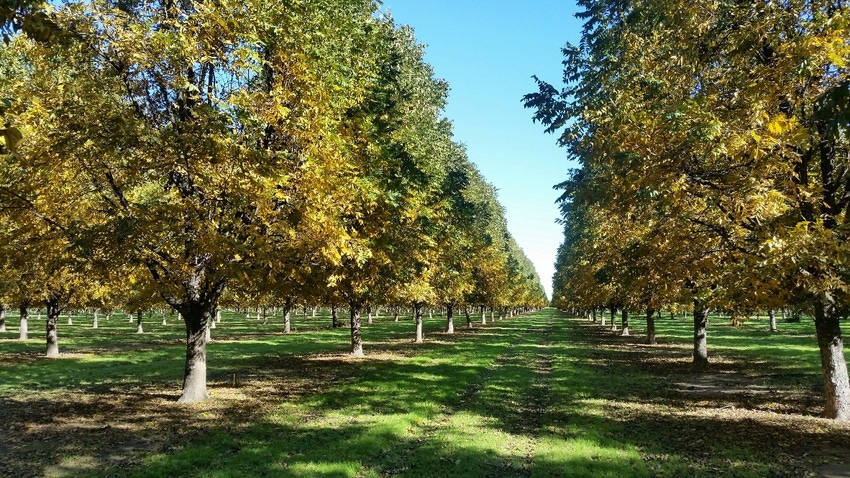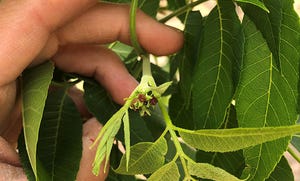
Southwest pecan producers are hoping for an “on year” in 2021, and Texas and New Mexico Extension specialists say early observations indicate potential for a good crop.
Many Texas producers have had heavy rainfall this spring, a mixed blessing offering ample moisture but also ample opportunity for disease issues.
New Mexico hopes to recover from back-to-back fall freezes in 2019 and 2020 that caused significant damage to orchards.
 Pecans flowering at the NMSU Leyendecker Plant Sciences Research Center in the Mesilla Valley. (Photo by Richard Heerema)
Pecans flowering at the NMSU Leyendecker Plant Sciences Research Center in the Mesilla Valley. (Photo by Richard Heerema)
“It’s too early to estimate 2021 production,” says New Mexico State University Extension Pecan Specialist Richard Heerema, Las Cruces. “But we have the potential to make a crop,” he adds.
The industry needs a good year.
Heerema says hard fall freezes the last two years did significant damage to pecan orchards and contributed to lower production.
“At the end of October and early November (Halloween and the following day 2019), a severe freeze in New Mexico, extending into Arizona and parts of Texas, did quite a bit of damage especially to newer orchards and to Wichita pecans.”
Heerema says a lot of New Mexico producers had to reevaluate, and those with young orchards almost had to “start from scratch” in 2020. Most did not have to replant, but they did reevaluate to determine how many trees froze back to the rootstock requiring regrafting, how many were totally dead, and what they could save without regrafting.
Still recovering
“We are still recovering from that freeze,” he says.
Some older trees, he adds, might not have shown visible damage. “A few did show damage, but it was rare. Still, the freeze is one reason why production in New Mexico was lower in 2020. A lot of our orchards’ production was down. It’s more complex than that, but the freeze was a factor.”
He says a lot of orchards went into last winter (2020) under a different scenario, a “significantly lower crop load.”
But Mother Nature wasn’t through.
“We had another freeze in early October 2020,” Heerema says. “Freezes two years in a row affected some of the same areas, also some in Arizona and Texas. The Mesilla Valley (New Mexico’s main pecan growing area) had cloud cover and some snow, so temperatures were not as low as in 2019, and the crop was not stressed as much.
“Our fear was that snow accumulation would result in a lot of limb breakage since trees still had a lot of leaves. We did not see much breakage in the Mesilla Valley. But other areas in New Mexico got very cold last October, a repeat of 2019. It is unfortunate.”
Promising start
Heerema says he has not traveled to a lot of New Mexico’s pecan orchards so far this spring to check the crop load, but what he has seen looks promising.
“Some orchards around the Las Cruces area look like they have good flower production. This indicates at least the potential for a bigger crop load than the last two years. We’re not expecting an off-year-type crop. Things look better than previous years, as far as flowers.”
He says the crop has a long way to go. “Flowers are promising but every flower will not set a nut. A lot can happen. But flowers are there now, and pollination is occurring.
“It is very early, but this is an important point: if we don’t see flowers, we have no chance of making a crop. That’s not the situation. The flowers are there. So, we do have potential. Now, we need to set the flowers into a nut crop.”
Moisture could be an issue as the crop moves into the summer months. “Most of New Mexico’s pecan production area is quite dry,” Heerema says. “Southeast New Mexico had a little rain last week. Not much rain has fallen in the Mesilla Valley. We need more precipitation to make the crop.”
Texas
Much of Texas has ample moisture going into the summer. Spring rainfall across much of the state should be good for the pecan crop, although it might complicate management.
“Rain is good for pecan trees this time of the year, because they need excellent soil moisture to grow the leaves, which are primarily made in April, May and June,” says Texas A&M AgriLife Extension Horticulture Specialist Monte Nesbitt, College Station.
But he adds a caveat. “That being said, rainfall increases incidence and severity of pecan scab, Fusicladum effusum, the most important disease of pecan trees. It is very likely that initial infections for scab have been promoted by this rainy weather and will begin to manifest in the next month on leaves and developing fruit.”
Nesbitt says a newcomer also poses a threat. “A fairly new troublesome fungal disease, pecan leaf dieback, can cause heavy leaf loss in June and July,” he says. “That is a real negative for this year and next year’s pecan crop. We’ve not observed it yet, but these rainy conditions have been favorable.”
Other issues
Disease issues are not the only challenges pecan producers face with persistent rainfall.
“Rainy weather keeps growers from spraying on time,” Nesbitt says. “This is a key window for spraying pecan trees for pecan nut casebearer, an early-season lepidopteran (moth) insect that can cause the number of nuts on trees to decline. Additionally, the rain disrupts timing of fungicides for pecan scab.”
He says crop conditions vary across the state. “Grower reports of crop volume are mixed, with some reports of excellent production and some indicating low to moderate nut set. The far West area (El Paso) has been described as light. It’s still too early to know where that will be by harvest because we still have time for pollination drop and then the casebearer injury.
“I believe we will see Texas with a moderate to good crop over most of the state.”
Texas produced 45.4 million pounds of pecans last year, third behind Georgia and New Mexico, according to the USDA National Agriculture Statistics Service.
Nationwide, 2020 pecan production was up, compared to 2019, according to NASS.
See, Export market important for pecans
NASS reports an 18% increase in pecans production over 2019. “Bearing acreage was estimated at 402,000, up 2% from the previous year,” NASS reports.
Other statistics:
2020 average yield was 752 pounds per acre, up 105 pounds from the previous year.
Crop value totaled $399 million, down 15% from the previous season with an average annual price of $1.32 per pound.
Improved variety pecan production, 288 million pounds, up 25% from the previous year.
Improved variety pecans accounted for 95% of the United States total pecan production.
Native and seedling variety production totaled 14.2 million pounds, down 42% from 2019.
Georgia had the highest utilized production (in-shell basis) at 142 million pounds, followed by New Mexico at 77.0 million pounds (in-shell basis) and Texas at 45.4 million pounds.
Read more about:
PecansAbout the Author(s)
You May Also Like






